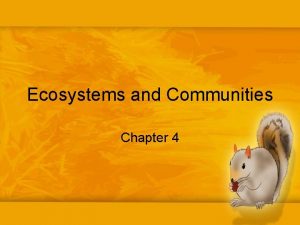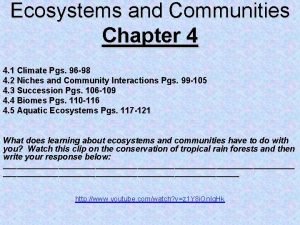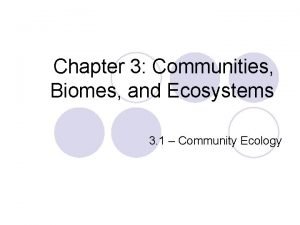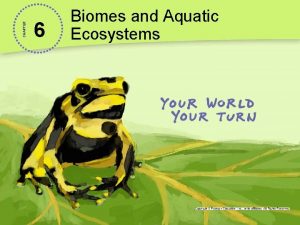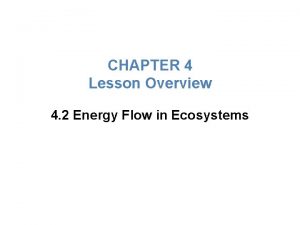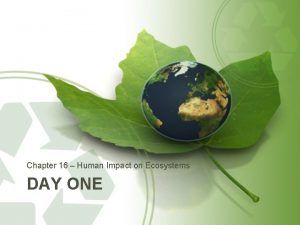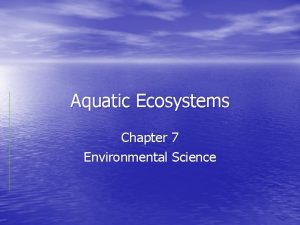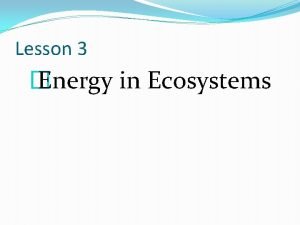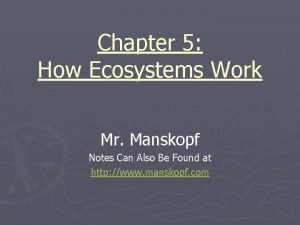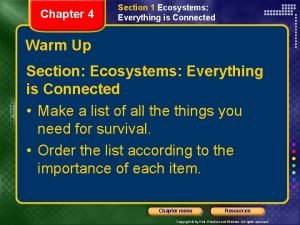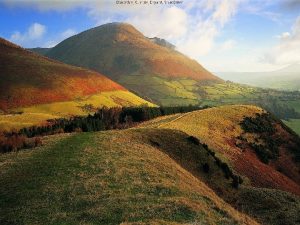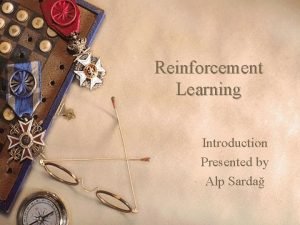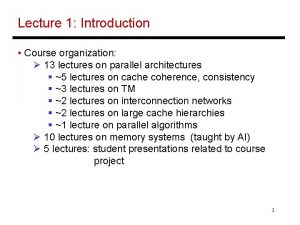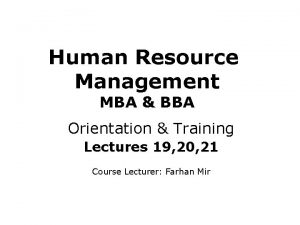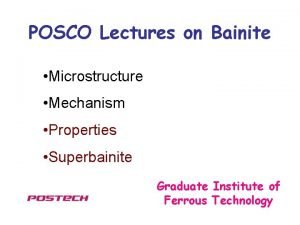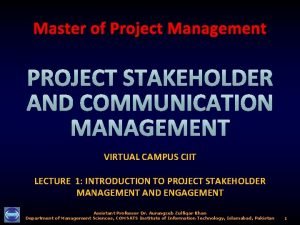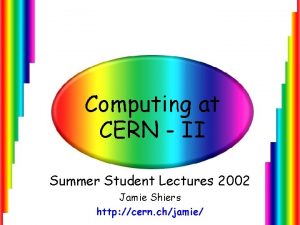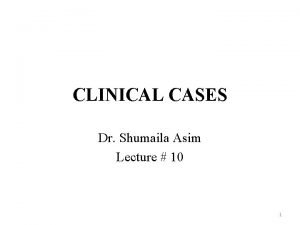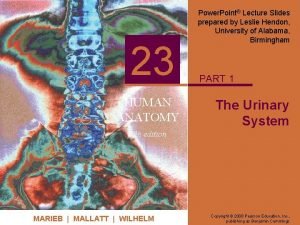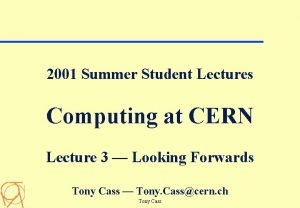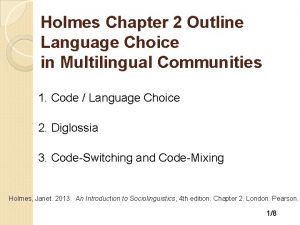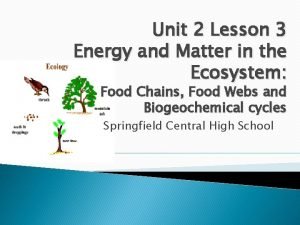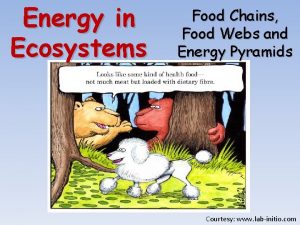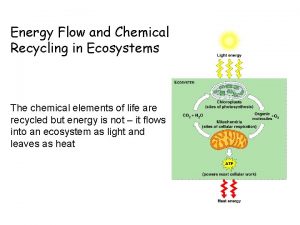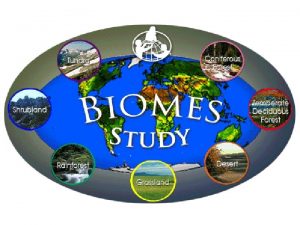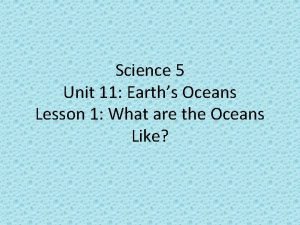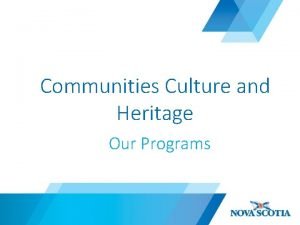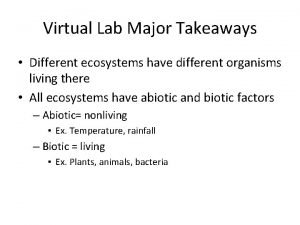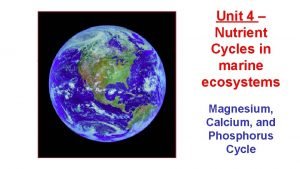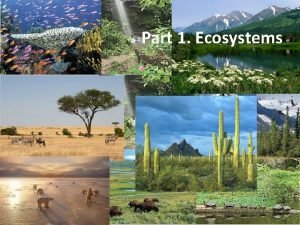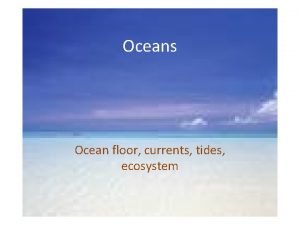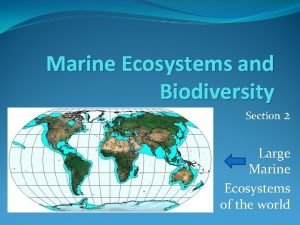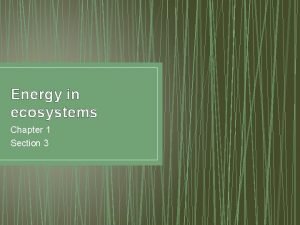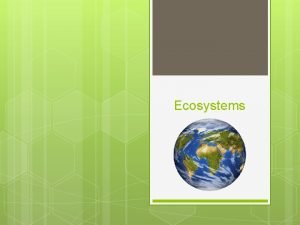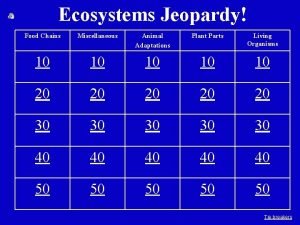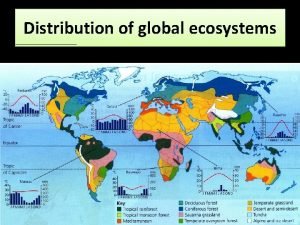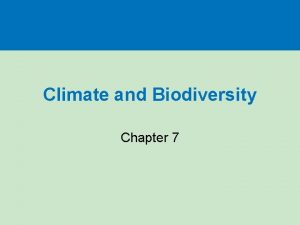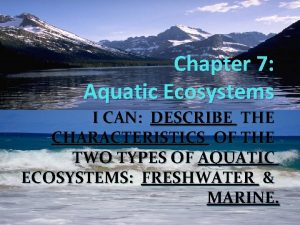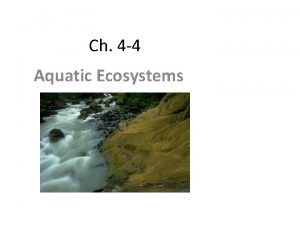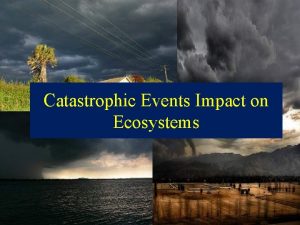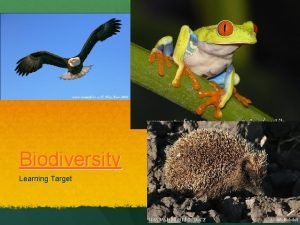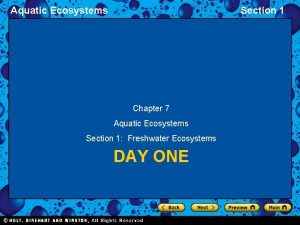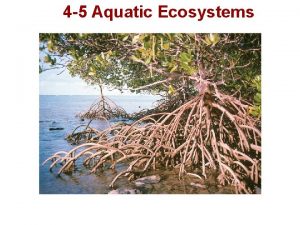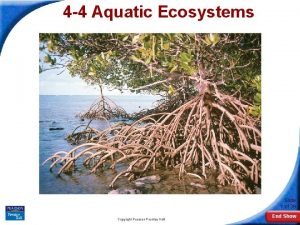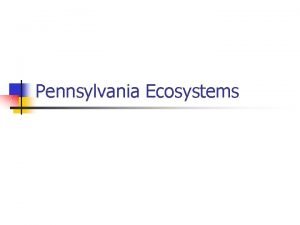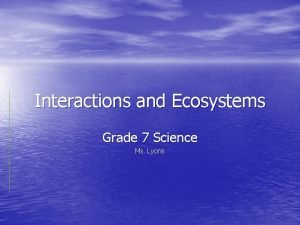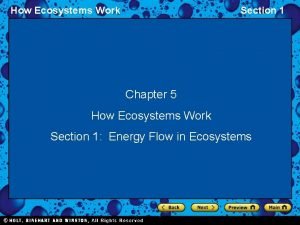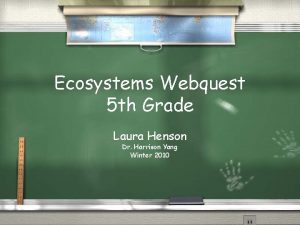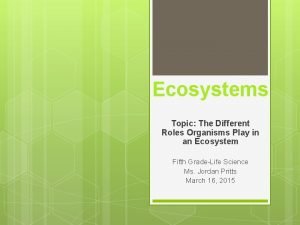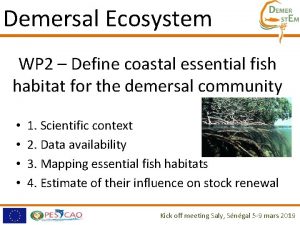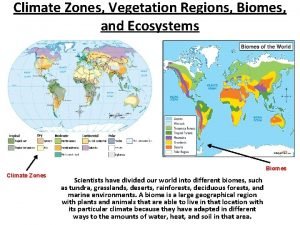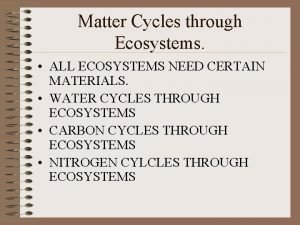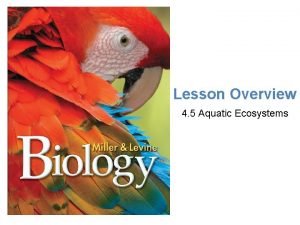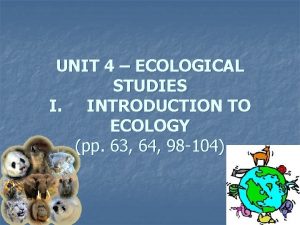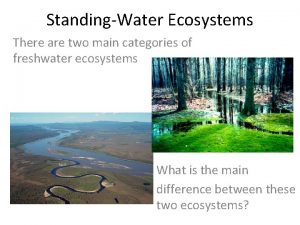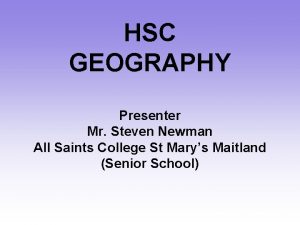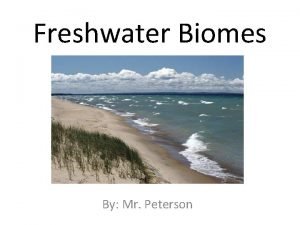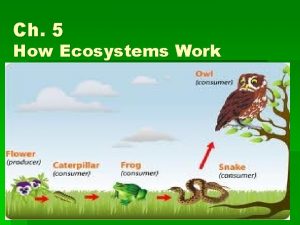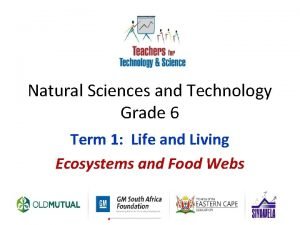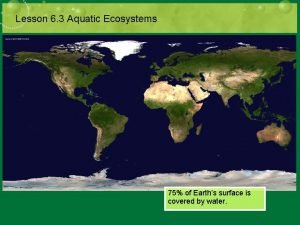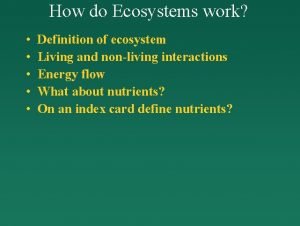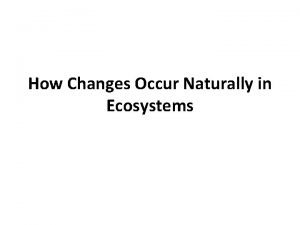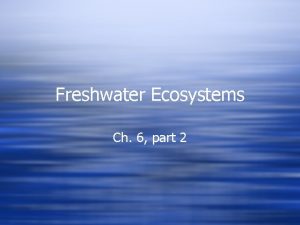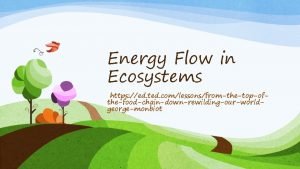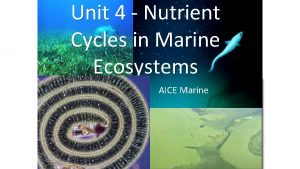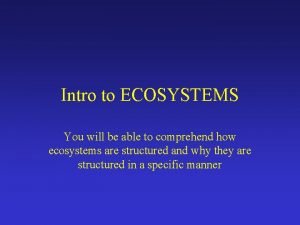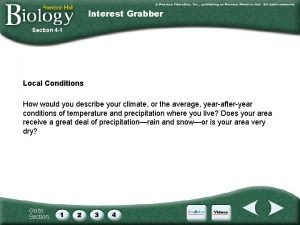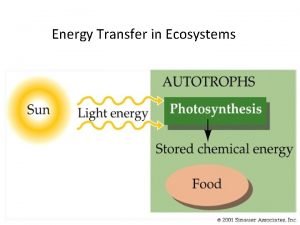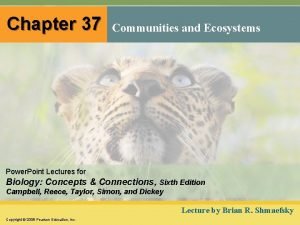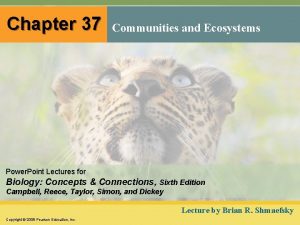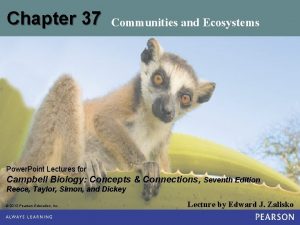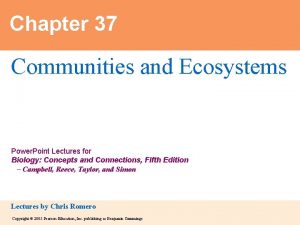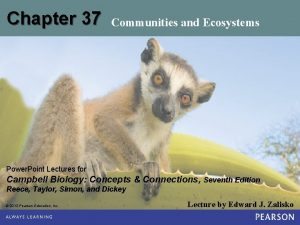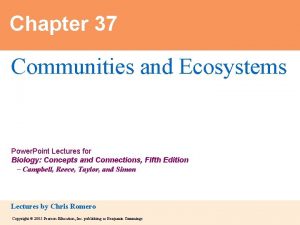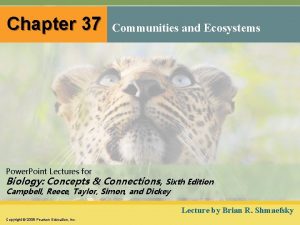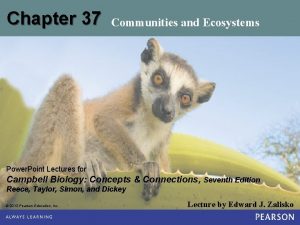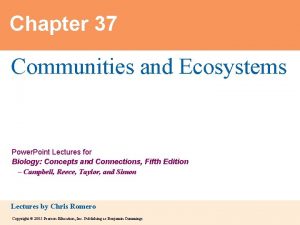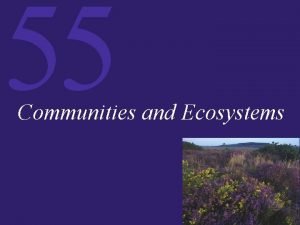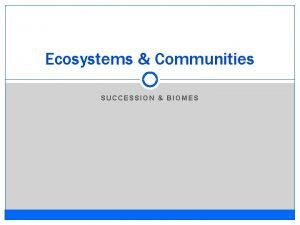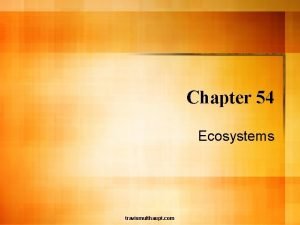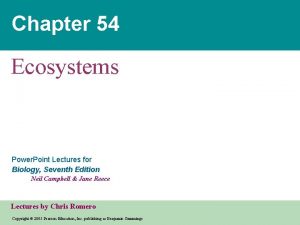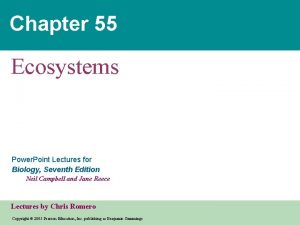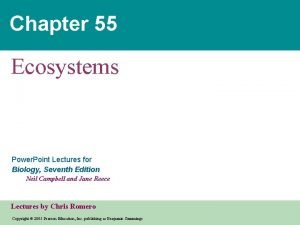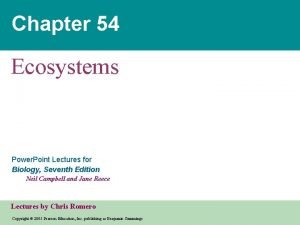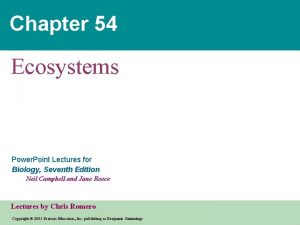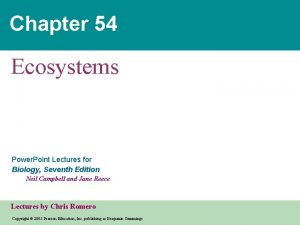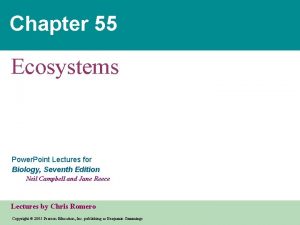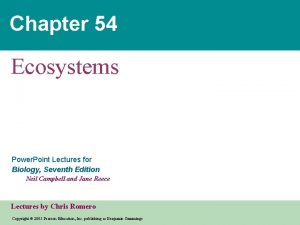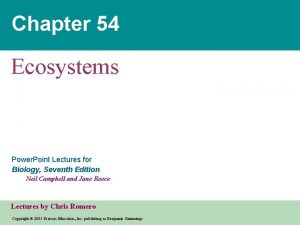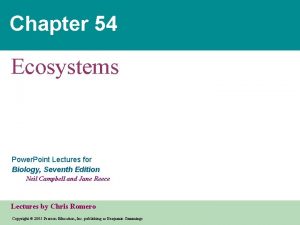CHAPTER 19 Communities and Ecosystems Power Point Lectures


















































































































































- Slides: 146

CHAPTER 19 Communities and Ecosystems Power. Point® Lectures for Essential Biology, Third Edition – Neil Campbell, Jane Reece, and Eric Simon Essential Biology with Physiology, Second Edition – Neil Campbell, Jane Reece, and Eric Simon Lectures by Chris C. Romero Copyright © 2007 Pearson Education Inc. , publishing as Pearson Benjamin Cummings





Biology and Society: Reefs, Coral and Artificial • Coral reefs – Are distinctive and complex ecosystems. – Support a diversity of organisms. Coral Reef Copyright © 2007 Pearson Education Inc. , publishing as Pearson Benjamin Cummings

Figure 19. 1

• Human activity – Can easily degrade coral reefs. • Artificial reefs – Are being created by humans to help replace those that have been destroyed. Copyright © 2007 Pearson Education Inc. , publishing as Pearson Benjamin Cummings

Key Properties of Communities • A community – Is an assemblage of species living close enough together for potential interaction. Copyright © 2007 Pearson Education Inc. , publishing as Pearson Benjamin Cummings

Figure 19. 2

Diversity • The diversity of a community – Is the variety of different kinds of organisms that make up the community. Copyright © 2007 Pearson Education Inc. , publishing as Pearson Benjamin Cummings

• The diversity of a community has two components: – Species richness, the total number of different species in the community – Relative abundance of the different species Copyright © 2007 Pearson Education Inc. , publishing as Pearson Benjamin Cummings

Figure 19. 3

Prevalent Form of Vegetation • The prevalent form of vegetation mainly depends on the terrestrial situation. • The types and structural features of plants in a community largely determine the kinds of animals that live in the community. Copyright © 2007 Pearson Education Inc. , publishing as Pearson Benjamin Cummings

Stability • Community stability – Refers to the community’s ability to resist change and return to its original species combination after being disturbed. – Depends on both the type of community and the nature of disturbances. Copyright © 2007 Pearson Education Inc. , publishing as Pearson Benjamin Cummings

Trophic Structure • The trophic structure of a community concerns the feeding relationships among the various species making up the community. Copyright © 2007 Pearson Education Inc. , publishing as Pearson Benjamin Cummings

Figure 19. 4

Interspecific Interactions in Communities • Interspecific interactions are interactions between species. Copyright © 2007 Pearson Education Inc. , publishing as Pearson Benjamin Cummings

Competition Between Species • Interspecific competition – May occur when two or more species in a community rely on similar limiting resources. – May limit population growth of the competing species. Copyright © 2007 Pearson Education Inc. , publishing as Pearson Benjamin Cummings

The Process of Science: What Happens When Species Compete? • Russian ecologist G. F. Gause studied the effects of interspecific competition in two closely related species of protists. Copyright © 2007 Pearson Education Inc. , publishing as Pearson Benjamin Cummings

Figure 19. 5

• From his research, Gause concluded that two species so similar that they compete for the same limiting resources cannot coexist in the same place. • Ecologists called this concept the competitive exclusion principle. Copyright © 2007 Pearson Education Inc. , publishing as Pearson Benjamin Cummings

• Testing the competitive exclusion principle Copyright © 2007 Pearson Education Inc. , publishing as Pearson Benjamin Cummings

Figure 19. 6

The Ecological Niche • A species’ ecological niche – Is the sum total of a species’ use of the biotic and abiotic resources in its environment. – Is the species’ ecological role. Copyright © 2007 Pearson Education Inc. , publishing as Pearson Benjamin Cummings

• We can now restate the competitive exclusion principle as follows: – Two species cannot coexist in a community if their niches are identical. Copyright © 2007 Pearson Education Inc. , publishing as Pearson Benjamin Cummings

Resource Partitioning • There are two possible outcomes of competition between species with identical niches: – Extinction of one species – Evolution of one species to use a different set of resources Copyright © 2007 Pearson Education Inc. , publishing as Pearson Benjamin Cummings

• Resource partitioning – Is the differentiation of niches that enables similar species to coexist in a community. Copyright © 2007 Pearson Education Inc. , publishing as Pearson Benjamin Cummings

Figure 19. 7

Predation • Predation – Is when organisms eat other organisms. – Identifies the predator as the consumer and the food species as the prey. – Includes herbivory, the consumption of plants by animals. Copyright © 2007 Pearson Education Inc. , publishing as Pearson Benjamin Cummings

Predator Adaptations • Most predators have acute senses. • Many predators – Have adaptations such as claws, teeth, fangs, stingers, or poison to help catch and subdue prey. – Are fast and agile. Copyright © 2007 Pearson Education Inc. , publishing as Pearson Benjamin Cummings

Plant Defenses Against Herbivores • Plants have various types of defenses against herbivores: – Chemical toxins – Spines and thorns Copyright © 2007 Pearson Education Inc. , publishing as Pearson Benjamin Cummings

Animal Defenses Against Predators • Animals can avoid being eaten – By using passive defenses such as hiding. – By using active defenses such as escaping or defending themselves. Copyright © 2007 Pearson Education Inc. , publishing as Pearson Benjamin Cummings

• Behavioral defenses include – Alarm calls. – Mobbing. Copyright © 2007 Pearson Education Inc. , publishing as Pearson Benjamin Cummings

Figure 19. 8

• Distraction displays – Direct the attention of the predator away from a vulnerable prey to another prey that is more likely to escape. Copyright © 2007 Pearson Education Inc. , publishing as Pearson Benjamin Cummings

Figure 19. 9

• Camouflage, or cryptic coloration, – Is a passive defense that makes a potential prey difficult to spot against its background. Seahorse Camouflage Copyright © 2007 Pearson Education Inc. , publishing as Pearson Benjamin Cummings

Figure 19. 10

• Some animals – Have mechanical or chemical defenses against predators. Copyright © 2007 Pearson Education Inc. , publishing as Pearson Benjamin Cummings

• Animals with chemical defenses are often brightly colored. – This is a caution to predators called warning coloration. Copyright © 2007 Pearson Education Inc. , publishing as Pearson Benjamin Cummings

Figure 19. 11

• Mimicry – Is a “copycat” adaptation in which one species mimics the appearance of another. – Is used by some species to gain protection. Copyright © 2007 Pearson Education Inc. , publishing as Pearson Benjamin Cummings

• In Batesian mimicry, – A palatable or harmless species mimics an unpalatable or harmful model. Copyright © 2007 Pearson Education Inc. , publishing as Pearson Benjamin Cummings

Figure 19. 12

• In Müllerian mimicry, – Two or more unpalatable species resemble each other. Copyright © 2007 Pearson Education Inc. , publishing as Pearson Benjamin Cummings

Figure 19. 13

Predation and Species Diversity in Communities • Predator-prey relationships – Can actually preserve species diversity. Copyright © 2007 Pearson Education Inc. , publishing as Pearson Benjamin Cummings

• The experiments of Robert Paine – Removed a dominant predator from a community. – Provided evidence of the importance of predation. Copyright © 2007 Pearson Education Inc. , publishing as Pearson Benjamin Cummings

Figure 19. 14

• Paine’s experiments and others – Led to the concept of keystone predators. • Keystone predators – Help maintain species diversity by preventing competitive exclusion of weaker competitors. Copyright © 2007 Pearson Education Inc. , publishing as Pearson Benjamin Cummings

Symbiotic Relationships • A symbiotic relationship – Is an interaction between two or more species that live together in direct contact. Copyright © 2007 Pearson Education Inc. , publishing as Pearson Benjamin Cummings

Parasitism • Parasitism – Is a symbiotic relationship in which one organism benefits while the other is harmed. • The parasite – Obtains its nutrients by living in or on its host organism. Copyright © 2007 Pearson Education Inc. , publishing as Pearson Benjamin Cummings

• Natural selection – Has refined the relationships between parasites and their hosts. – Can rapidly temper host-parasite relationships. Copyright © 2007 Pearson Education Inc. , publishing as Pearson Benjamin Cummings

Figure 19. 15

Mutualism • Mutualism – Is a symbiosis that benefits both partners. Clownfish and Anemone Copyright © 2007 Pearson Education Inc. , publishing as Pearson Benjamin Cummings

Figure 19. 16

• Many mutualistic relationships have evolved from predator-prey or host-parasite interactions. Copyright © 2007 Pearson Education Inc. , publishing as Pearson Benjamin Cummings

The Complexity of Community Networks • The branching of interactions between species makes communities complex. Copyright © 2007 Pearson Education Inc. , publishing as Pearson Benjamin Cummings

Figure 19. 17

Disturbance of Communities • Disturbances – Are episodes that damage biological communities, at least temporarily. – Destroy organisms and alter the availability of resources. – Affect all communities. Copyright © 2007 Pearson Education Inc. , publishing as Pearson Benjamin Cummings

Ecological Succession • Ecological succession – Is the process of community change. Copyright © 2007 Pearson Education Inc. , publishing as Pearson Benjamin Cummings

• In primary succession – A community arises in a virtually lifeless area with no soil. Copyright © 2007 Pearson Education Inc. , publishing as Pearson Benjamin Cummings

Figure 19. 18, parts 1– 3

• Primary succession from barren soil to a complex community can take hundreds of years. Copyright © 2007 Pearson Education Inc. , publishing as Pearson Benjamin Cummings

Figure 19. 18, parts 4– 6

• Secondary succession occurs where a disturbance has destroyed an existing community but left the soil intact. Copyright © 2007 Pearson Education Inc. , publishing as Pearson Benjamin Cummings

A Dynamic View of Community Structure • Small-scale disturbances – Often have positive effects on a community. – May create new habitats. Copyright © 2007 Pearson Education Inc. , publishing as Pearson Benjamin Cummings

Figure 19. 19

• The intermediate disturbance hypothesis – States that species diversity may be greatest in an area where disturbance is moderate in both severity and frequency. Copyright © 2007 Pearson Education Inc. , publishing as Pearson Benjamin Cummings

An Overview of Ecosystem Dynamics • An ecosystem – Is a biological community and the abiotic factors with which the community interacts. Copyright © 2007 Pearson Education Inc. , publishing as Pearson Benjamin Cummings

• Energy flow – Is the passage of energy through the components of the ecosystem. • Chemical cycling – Is the use and reuse of chemical elements within the ecosystem. Copyright © 2007 Pearson Education Inc. , publishing as Pearson Benjamin Cummings

• Energy – Flows through an ecosystem when consumers feed on producers. – Cannot be recycled within an ecosystem, but must flow through continuously. Copyright © 2007 Pearson Education Inc. , publishing as Pearson Benjamin Cummings

Figure 19. 20

• Energy flow and chemical cycling – Depend on the transfer of substances in the feeding relationships, or trophic structure, of an ecosystem. • Trophic relationships – Determine an ecosystem’s routes of energy flow and chemical cycling. • Trophic levels – Divide the species of an ecosystem based on their main sources of nutrition. Copyright © 2007 Pearson Education Inc. , publishing as Pearson Benjamin Cummings

Trophic Levels and Food Chains • A food chain – Is the sequence of food transfer from trophic level to trophic level. – May have many levels. Shark Eating Seal Copyright © 2007 Pearson Education Inc. , publishing as Pearson Benjamin Cummings

Figure 19. 21

• Herbivores, which eat plants, algae, or autotrophic bacteria, are the primary consumers of an ecosystem. • Above the primary consumers, the trophic levels are made up of carnivores, which eat the consumers from the levels below: – Secondary consumers include many small mammals, such as rodents, and small fishes that eat zooplankton. – Tertiary consumers, such as snakes, eat mice and other. secondary consumers. – Quaternary consumers include hawks and killer whales. Copyright © 2007 Pearson Education Inc. , publishing as Pearson Benjamin Cummings

• Detritivores, or decomposers, – Derive their energy from the dead material left by all trophic levels. – Are often left off of most food chain diagrams. Copyright © 2007 Pearson Education Inc. , publishing as Pearson Benjamin Cummings

Figure 19. 22

Food Webs • The feeding relationships in an ecosystem – Are typically not as simple as in an unbranched food chain. – Are usually woven into elaborate food webs. Copyright © 2007 Pearson Education Inc. , publishing as Pearson Benjamin Cummings

Figure 19. 23

Energy Flow in Ecosystems • What limits the length of food chains? – How do lessons about energy flow apply to human nutrition? Copyright © 2007 Pearson Education Inc. , publishing as Pearson Benjamin Cummings

Productivity and the Energy Budgets of Ecosystems • Biomass – Is the amount of organic material in an ecosystem. • An ecosystem’s primary productivity – Is the rate at which plants and other producers build biomass. Copyright © 2007 Pearson Education Inc. , publishing as Pearson Benjamin Cummings

Figure 19. 24

Energy Pyramids • When energy flows as organic matter through the trophic levels of an ecosystem, much of it is lost at each link in the food chain. Copyright © 2007 Pearson Education Inc. , publishing as Pearson Benjamin Cummings

Figure 19. 25

• An energy pyramid – Is a diagram that represents the cumulative loss of energy from a food chain. Copyright © 2007 Pearson Education Inc. , publishing as Pearson Benjamin Cummings

Figure 19. 26

Ecosystem Energetics and Human Nutrition • The dynamics of energy flow apply to the human population. Copyright © 2007 Pearson Education Inc. , publishing as Pearson Benjamin Cummings

• Eating producers instead of consumers requires less photosynthetic productivity and reduces the impact on the environment. Copyright © 2007 Pearson Education Inc. , publishing as Pearson Benjamin Cummings

Figure 19. 27

Chemical Cycling in Ecosystems • Ecosystems – Depend on a recycling of chemical elements. Copyright © 2007 Pearson Education Inc. , publishing as Pearson Benjamin Cummings

The General Scheme of Chemical Cycling • Biogeochemical cycles – Are chemical cycles in an ecosystem that involve both biotic and abiotic components. Copyright © 2007 Pearson Education Inc. , publishing as Pearson Benjamin Cummings

• Three key points to biogeochemical cycles: – Each circuit has an abiotic reservoir. – A portion of chemical cycling can rely completely on geological processes. – Some chemicals require processing before they are available as inorganic nutrients. Copyright © 2007 Pearson Education Inc. , publishing as Pearson Benjamin Cummings

• Generalized scheme for biogeochemical cycles Copyright © 2007 Pearson Education Inc. , publishing as Pearson Benjamin Cummings

Figure 19. 28

Examples of Biogeochemical Cycles • A chemical’s specific route through an ecosystem varies with the particular element and the trophic structure of the ecosystem. Copyright © 2007 Pearson Education Inc. , publishing as Pearson Benjamin Cummings

Figure 19. 29 a

Figure 19. 29 b

Figure 19. 29 c

Figure 19. 29 d

Biomes • Biomes – Are the major types of ecosystems that cover large geographic regions of the Earth. Copyright © 2007 Pearson Education Inc. , publishing as Pearson Benjamin Cummings

How Climate Affects Biome Distribution • Because of its curvature, Earth receives an uneven distribution of solar energy. Copyright © 2007 Pearson Education Inc. , publishing as Pearson Benjamin Cummings

Figure 19. 30

• Heated by the direct rays of the sun, air at the equator rises, then cools, forms clouds, and drops rain. Copyright © 2007 Pearson Education Inc. , publishing as Pearson Benjamin Cummings

Figure 19. 31

• Proximity to large bodies of water and the presence of landforms such as mountain ranges also affect climate. Copyright © 2007 Pearson Education Inc. , publishing as Pearson Benjamin Cummings

Figure 19. 32

Terrestrial Biomes • The distribution of terrestrial biomes depends largely on climate. • If the climate in two geographically separate areas is similar, the same type of biome may occur in them. Copyright © 2007 Pearson Education Inc. , publishing as Pearson Benjamin Cummings

• Most biomes – Are named for major physical or climatic features and for their predominant vegetation. Copyright © 2007 Pearson Education Inc. , publishing as Pearson Benjamin Cummings

Figure 19. 33

Figure 19. 34 a

Figure 19. 34 b

Figure 19. 34 c

Figure 19. 34 d

Figure 19. 34 e

Figure 19. 34 f

Figure 19. 34 g

Figure 19. 34 h

Freshwater Biomes • Aquatic biomes – Occupy the largest part of the biosphere. Copyright © 2007 Pearson Education Inc. , publishing as Pearson Benjamin Cummings

Lakes and Ponds • Standing bodies of water – Range from small ponds to large lakes. Copyright © 2007 Pearson Education Inc. , publishing as Pearson Benjamin Cummings

Figure 19. 35 a

• In lakes and large ponds, – The communities of plants, algae, and animals are distributed according to the depth of water and its distance from shore. Copyright © 2007 Pearson Education Inc. , publishing as Pearson Benjamin Cummings

• The photic zone – Includes the shallow water near shore and the upper stratum of water away from shore. – Is named because light is available for photosynthesis. Copyright © 2007 Pearson Education Inc. , publishing as Pearson Benjamin Cummings

• The aphotic zone – Is deeper, where light levels are too low to support photosynthesis. • The benthic zone – Is the bottom of all aquatic biomes. Copyright © 2007 Pearson Education Inc. , publishing as Pearson Benjamin Cummings

Rivers and Streams • Rivers and streams – Are bodies of water flowing in one direction. – Support quite different communities of organisms than lakes and ponds. Copyright © 2007 Pearson Education Inc. , publishing as Pearson Benjamin Cummings

Figure 19. 35 b

• Marshes, ponds, and other wetlands – Are common in downstream areas. Copyright © 2007 Pearson Education Inc. , publishing as Pearson Benjamin Cummings

Figure 19. 35 c

• Human activities have affected many streams and rivers. Copyright © 2007 Pearson Education Inc. , publishing as Pearson Benjamin Cummings

Figure 19. 36

Marine Biomes • Oceans – Cover about 75% of the planet’s surface. Copyright © 2007 Pearson Education Inc. , publishing as Pearson Benjamin Cummings

Estuaries • Estuaries – Are areas where a freshwater stream or river merges with the ocean. – Are one of the most biologically productive environments on Earth. Copyright © 2007 Pearson Education Inc. , publishing as Pearson Benjamin Cummings

Figure 19. 37

Major Oceanic Zones • Marine life is distributed according to – Depth of the water. – Degree of light penetration. – Distance from shore. – Open water versus bottom. Copyright © 2007 Pearson Education Inc. , publishing as Pearson Benjamin Cummings

• Oceanic zones Copyright © 2007 Pearson Education Inc. , publishing as Pearson Benjamin Cummings

Figure 19. 38

• The intertidal zone – Is the area where land meets water. – Includes organisms adapted to attach to rocks or vegetation or to burrow. Copyright © 2007 Pearson Education Inc. , publishing as Pearson Benjamin Cummings

Figure 19. 39

• The pelagic zone – Is the open ocean. – Contains phytoplankton and zooplankton. Copyright © 2007 Pearson Education Inc. , publishing as Pearson Benjamin Cummings

• The benthic zone – Is the ocean bottom or seafloor. – May include hydrothermal vent communities. Hydrothermal Vent Tubeworms Copyright © 2007 Pearson Education Inc. , publishing as Pearson Benjamin Cummings

Figure 19. 40

Evolution Connection: Coevolution in Biological Communities • Coevolution – Describes adaptations of two species that are closely connected. Copyright © 2007 Pearson Education Inc. , publishing as Pearson Benjamin Cummings

• Coevolution of a plant and insect Copyright © 2007 Pearson Education Inc. , publishing as Pearson Benjamin Cummings

Figure 19. 41
 Chapter 4 ecosystems and communities vocabulary review
Chapter 4 ecosystems and communities vocabulary review Parasitism examples
Parasitism examples Three biotic factors
Three biotic factors Difference between primary and secondary succesion
Difference between primary and secondary succesion Power system lectures
Power system lectures Power triangle
Power triangle The chaparral biome is best characterized by _______.
The chaparral biome is best characterized by _______. 6 biomes and aquatic ecosystems
6 biomes and aquatic ecosystems Chapter 55 ecosystems and restoration ecology
Chapter 55 ecosystems and restoration ecology Chapter 42 ecosystems and energy
Chapter 42 ecosystems and energy Chapter 3 lesson 3 biomes and aquatic ecosystems
Chapter 3 lesson 3 biomes and aquatic ecosystems Chapter 55 ecosystems and restoration ecology
Chapter 55 ecosystems and restoration ecology Power bi training powerpoint
Power bi training powerpoint Point point power
Point point power Utilities and energy lecture
Utilities and energy lecture What is text linguistics
What is text linguistics Molecular biology lecture
Molecular biology lecture Aquatic areas
Aquatic areas Chapter 4 lesson 2 energy flow in ecosystems
Chapter 4 lesson 2 energy flow in ecosystems Chapter 16 human impact on ecosystems
Chapter 16 human impact on ecosystems Chapter 7 aquatic ecosystems
Chapter 7 aquatic ecosystems Energy in ecosystems lesson 3 answer key
Energy in ecosystems lesson 3 answer key Chapter 7 aquatic ecosystems test answers
Chapter 7 aquatic ecosystems test answers Chapter 5 how ecosystems work study guide
Chapter 5 how ecosystems work study guide Chapter 16 human impact on ecosystems
Chapter 16 human impact on ecosystems Section 1 ecosystems everything is connected answer key
Section 1 ecosystems everything is connected answer key Unit 5 ecology
Unit 5 ecology Rick trebino
Rick trebino Lectures paediatrics
Lectures paediatrics Data mining lectures
Data mining lectures Medicinal chemistry lectures
Medicinal chemistry lectures Uva powerpoint
Uva powerpoint Cs614 short lectures
Cs614 short lectures Planning a software project
Planning a software project Radio astronomy lectures
Radio astronomy lectures Dr sohail lectures
Dr sohail lectures Introduction to web engineering
Introduction to web engineering Do words have power
Do words have power Frcr physics lectures
Frcr physics lectures Frcr physics lectures
Frcr physics lectures Introduction to recursion
Introduction to recursion Blood physiology guyton
Blood physiology guyton Aerodynamics lectures
Aerodynamics lectures Theory of translation lectures
Theory of translation lectures Theory of translation lectures
Theory of translation lectures Digital logic design lectures
Digital logic design lectures Jim kurose
Jim kurose Hegel classical art
Hegel classical art Nuclear medicine lectures
Nuclear medicine lectures Gpoint c++
Gpoint c++ Cdeep lectures
Cdeep lectures Oral communication 3 lectures text
Oral communication 3 lectures text C programming lectures
C programming lectures Haematology lectures
Haematology lectures Bureau of lectures
Bureau of lectures Slagle lecture
Slagle lecture Theory of translation lectures
Theory of translation lectures Reinforcement learning lectures
Reinforcement learning lectures 13 lectures
13 lectures Reinforcement learning lectures
Reinforcement learning lectures Bba lectures
Bba lectures Medical emergency student lectures
Medical emergency student lectures Hematology medicine student lectures
Hematology medicine student lectures Rcog eportfolio
Rcog eportfolio Bhadeshia lectures
Bhadeshia lectures Yelena bogdan md
Yelena bogdan md Comsats virtual campus lectures
Comsats virtual campus lectures Hugh blair lectures on rhetoric
Hugh blair lectures on rhetoric Cern summer student lectures
Cern summer student lectures Pathology lectures for medical students
Pathology lectures for medical students Dr asim lectures
Dr asim lectures Pab ankle fracture
Pab ankle fracture Anatomy lectures powerpoint
Anatomy lectures powerpoint Cern summer school lectures
Cern summer school lectures Language choice in multilingual communities
Language choice in multilingual communities Differences between aquatic and terrestrial ecosystems
Differences between aquatic and terrestrial ecosystems Energy flow trophic levels
Energy flow trophic levels Lesson 3 energy and matter in ecosystems answer key
Lesson 3 energy and matter in ecosystems answer key Lab food chains and energy in ecosystems
Lab food chains and energy in ecosystems Energy flow and chemical recycling in ecosystems
Energy flow and chemical recycling in ecosystems Biomes and aquatic ecosystems
Biomes and aquatic ecosystems Water pollution impact on ecosystem
Water pollution impact on ecosystem 5 oceans of the world
5 oceans of the world Airline spoke model
Airline spoke model Solar power satellites and microwave power transmission
Solar power satellites and microwave power transmission Actual power and potential power
Actual power and potential power The dispersive power of grating increases with increasing
The dispersive power of grating increases with increasing Healing and rebuilding our communities
Healing and rebuilding our communities Communities culture and heritage
Communities culture and heritage Ecology virtual lab
Ecology virtual lab Prayer point for power and authority
Prayer point for power and authority Disadvantages of using powerpoint in teaching
Disadvantages of using powerpoint in teaching Biological use of magnesium in marine ecosystems
Biological use of magnesium in marine ecosystems Lesson outline lesson 2 aquatic ecosystems answer key
Lesson outline lesson 2 aquatic ecosystems answer key Ecosystem living and nonliving things
Ecosystem living and nonliving things The ecosystems
The ecosystems Ocean food chain
Ocean food chain Biodiversity
Biodiversity Interactions within ecosystems grade 7
Interactions within ecosystems grade 7 Section 3 energy in ecosystems
Section 3 energy in ecosystems Biomes title page
Biomes title page Ecosystem title page
Ecosystem title page Ecosystems jeopardy
Ecosystems jeopardy Distribution of global ecosystems
Distribution of global ecosystems Human impact on terrestrial ecosystems
Human impact on terrestrial ecosystems Aquatic ecosystems webquest
Aquatic ecosystems webquest Secondary succession biology definition
Secondary succession biology definition Section 4-4 aquatic ecosystems
Section 4-4 aquatic ecosystems Tornado impact to ecosystem
Tornado impact to ecosystem Why biodiversity is important
Why biodiversity is important What two locations are marine ecosystems usually located
What two locations are marine ecosystems usually located 4-4 aquatic ecosystems
4-4 aquatic ecosystems 4-4 aquatic ecosystems
4-4 aquatic ecosystems Section 4-4 aquatic ecosystems answer key
Section 4-4 aquatic ecosystems answer key Desert food web examples
Desert food web examples Pennsylvania ecosystems
Pennsylvania ecosystems Types of producers in science
Types of producers in science How ecosystems work
How ecosystems work Do birds eat squirrels
Do birds eat squirrels Aquatic ecosystems webquest
Aquatic ecosystems webquest Ecosystems jeopardy 5th grade
Ecosystems jeopardy 5th grade Define demersal
Define demersal Biomes
Biomes Matter cycling in ecosystems
Matter cycling in ecosystems How do ecologists usually classify marine ecosystems?
How do ecologists usually classify marine ecosystems? Primary consumer definition
Primary consumer definition Earth's ecosystems
Earth's ecosystems Intraspecific vs interspecific competition examples
Intraspecific vs interspecific competition examples Ecosystems interactions
Ecosystems interactions Standing water ecosystem
Standing water ecosystem Geography hsc syllabus
Geography hsc syllabus Fun facts about freshwater ecosystems
Fun facts about freshwater ecosystems Main ecosystems
Main ecosystems Section 1 energy flow in ecosystems
Section 1 energy flow in ecosystems Chapter 5 evolution and community ecology
Chapter 5 evolution and community ecology How ecosystems work
How ecosystems work Different ecosystems grade 6
Different ecosystems grade 6 Digital ecosystems nonprofits
Digital ecosystems nonprofits Lesson 3: aquatic ecosystems
Lesson 3: aquatic ecosystems How do ecosystems work
How do ecosystems work Types of succession
Types of succession Human impact on freshwater ecosystems
Human impact on freshwater ecosystems Ted ed ecosystems
Ted ed ecosystems Nutrient cycles in marine ecosystems
Nutrient cycles in marine ecosystems Intro to ecosystems
Intro to ecosystems Section 4-2 what shapes an ecosystem answer key
Section 4-2 what shapes an ecosystem answer key Ecosystem energy transfer
Ecosystem energy transfer
